|
|
Post by bixaorellana on Apr 15, 2011 0:16:07 GMT
According to legend, a band of angels appeared before one of the founders of Puebla, Bishop Julian Garcés, instructing him on where to locate the new city. Consequently, Puebla has been known as Angelópolis or the City of Angels. Whatever your beliefs, the soaring domes and elegant proportions of the city's profoundly beautiful cathedral will have you wondering if the fable of angels placing the bells in the towers might not be true. ~ ~ ~ ~ ~ ~ ~ ~ ~ ~ ~ ~ Construction on Puebla Cathedral began around 1535, but a few decades later, the plan for the cathedral was changed to a larger and more elaborate building. The new project began in 1575. After a few more decades of construction, the money ran out and the project again came to a halt in 1626. In 1634, the master architect of Mexico City Cathedral, Francisco Becerra, amended the plans for Puebla Cathedral yet again. His design gave it a more basilical appearance and incorporated the Neoclassical style. Construction started up again, and the cathedral was complete enough to be consecrated in April 1649 by the Bishop of Puebla, although work continued until nearly the end of the 18th century. The cathedral is the second-largest in the country after Mexico City Cathedral and its twin bell towers are the tallest in Mexico at 226 feet (69m). The interior has a Latin cross plan, with a wide central nave flanked by two aisles on each side. There are 14 chapels throughout the cathedral, all decorated in the Baroque style. Sources: www.sacred-destinations.com/mexico/puebla-cathedralwww.turismopuebla.gob.mx/wb/tur/catedral_1Please accompany me as I go goggle-eyed through this amazing structure. |
|
|
|
Post by bixaorellana on Apr 15, 2011 0:19:38 GMT
If you have seen my thread on the city of Puebla, you already have an idea of the beauty of the city. lightened by an extensive use of tile and wrought iron. Because of the dark brown of the native stone, though, the cathedral's exterior seems rather looming and plain. It's certainly big! This is one corner and gate into the church grounds. Beyond you see the federal palace. As you can see, there is traffic leading into the street around the zócalo. Indeed, there is traffic right in front of the many cafés around the square, but the area is so big, so green and pleasant, that the traffic is not a bother. 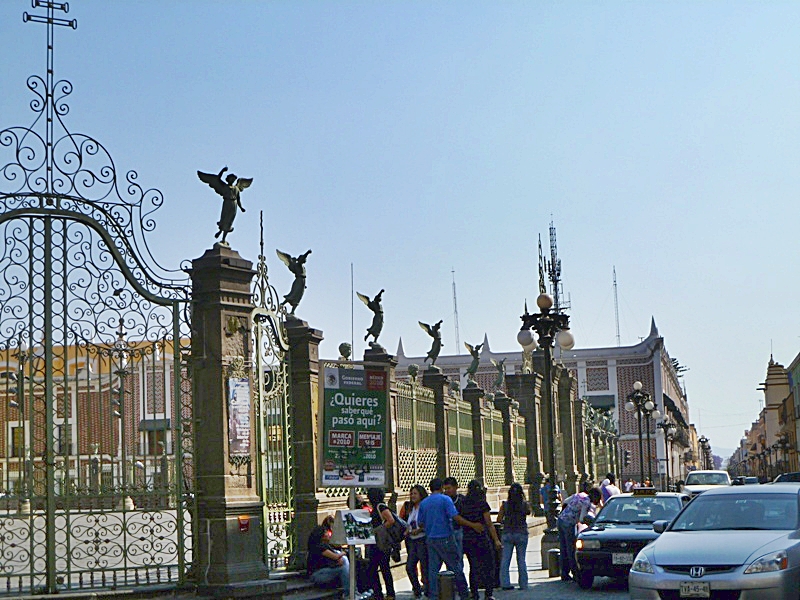 Just a very small portion of the massive expanse in front of the cathedral, again showing the federal palace. 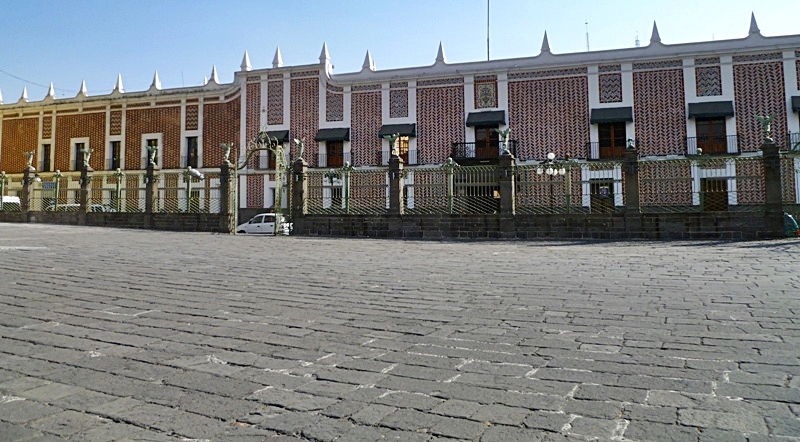 Another gate onto the churchyard, with a better view of the lovely work on the federal palace building. The graceful, even fun, wrought iron is so typical of this city. The angels are atop the fence all the way around, managing to be lightly angelic rather than solemn. 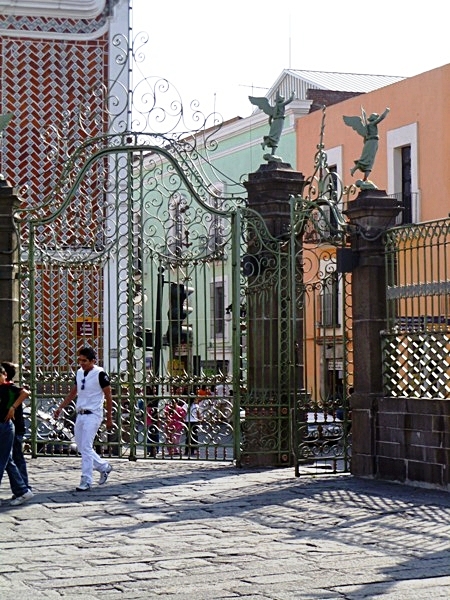 The side of the cathedral is closed off to traffic. This photo from the Puebla thread shows how the cathedral fence provides shade and seating and gives an idea of how very big the cathedral is. 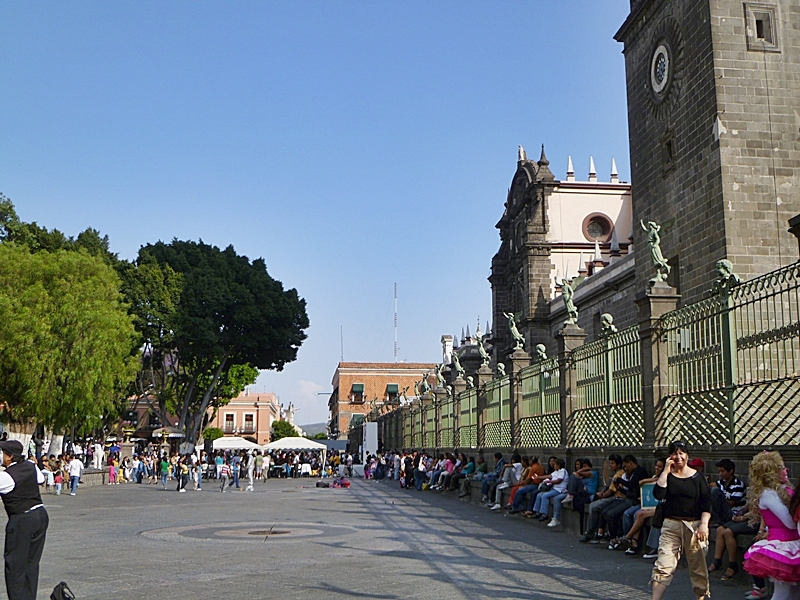 |
|
|
|
Post by bixaorellana on Apr 15, 2011 0:20:11 GMT
It's hard to fit the whole cathedral into a picture. I managed to get people into a couple of these, to give an idea of scale. Here's the middle of the church, then the left and the right towers. 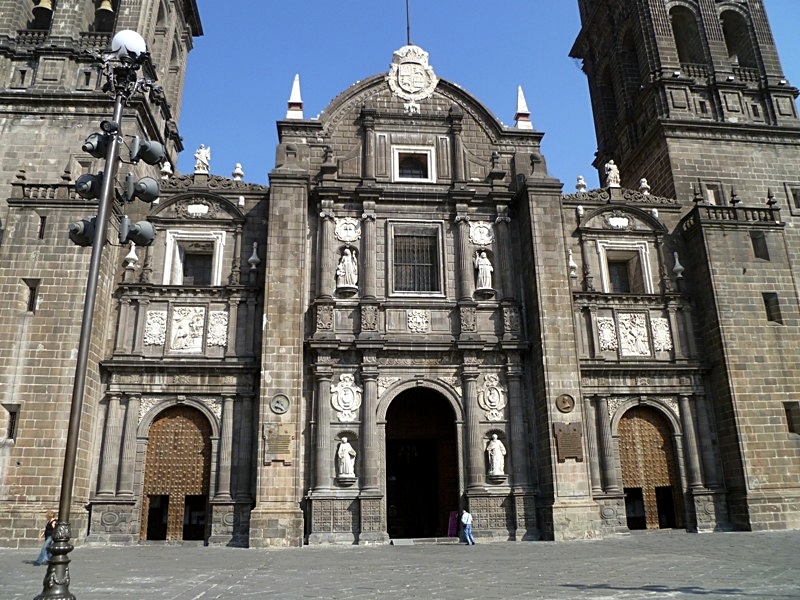 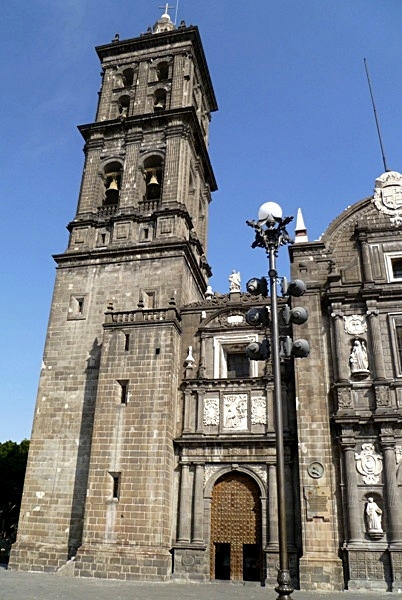 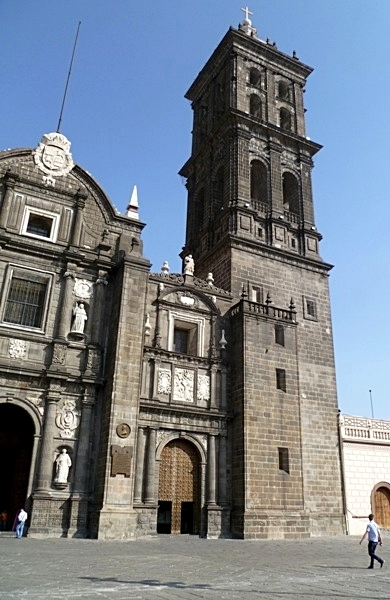 One of the friezes on the exterior ~ 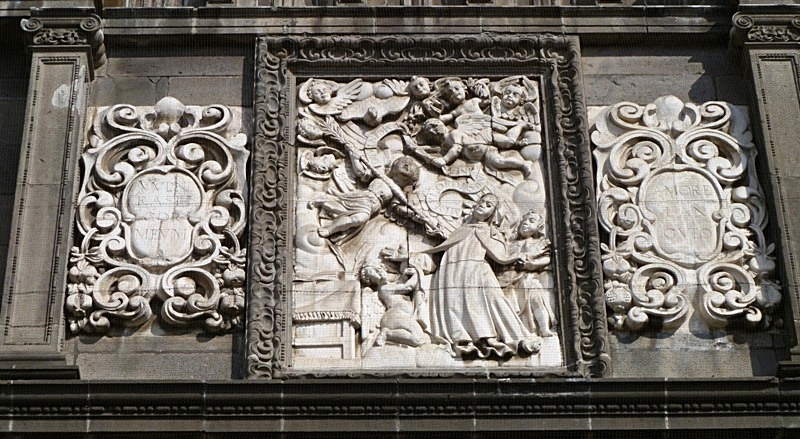 One panel of the huge middle door, which did not fit into my camera 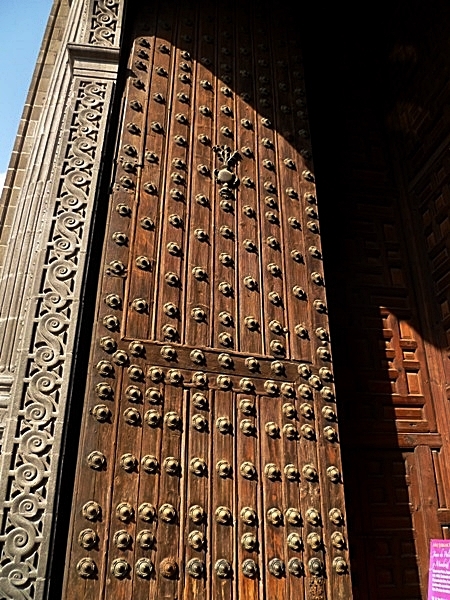 Exquisite stone work around the doors ~ 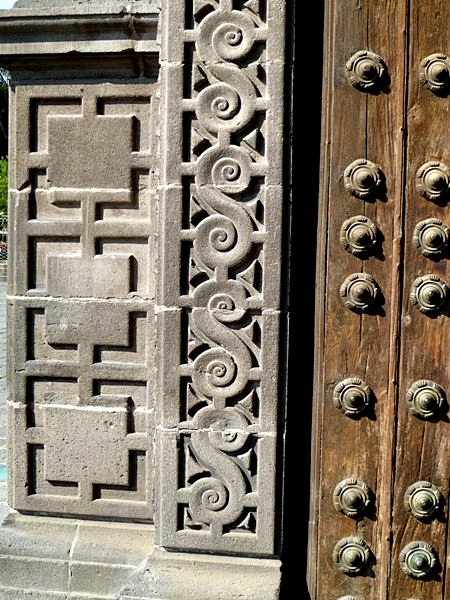 |
|
|
|
Post by bixaorellana on Apr 15, 2011 0:21:08 GMT
And we're inside! Please tolerate a few grainy, dark pictures taken here in the gloom by the front door, which are needed to give an idea of the sheer size of the place. I thought this was an odd place for a baptismal font, just inside the door. Then I realized it was only a holy water font, for people to dip their fingers in to make the sign of the cross as they entered the church! 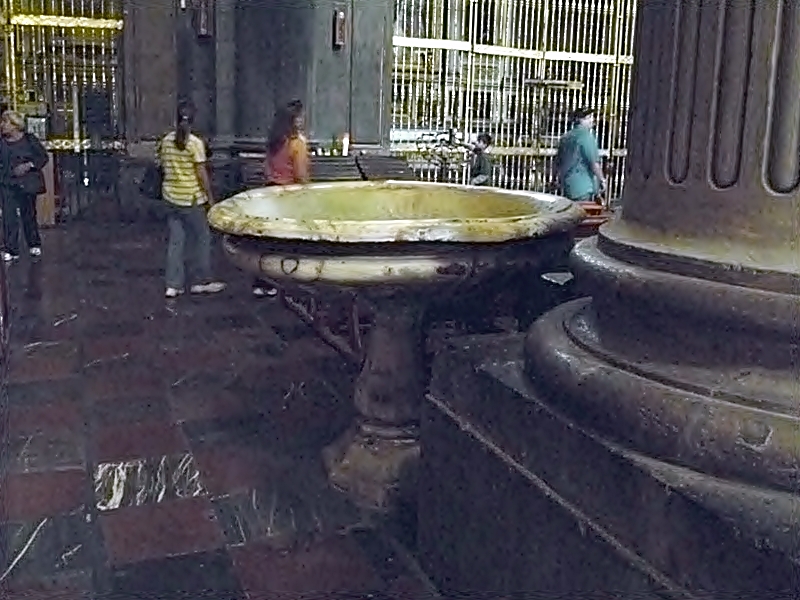 Most of the side chapels are gated up like this one, with too little light reaching in for me to get photos. 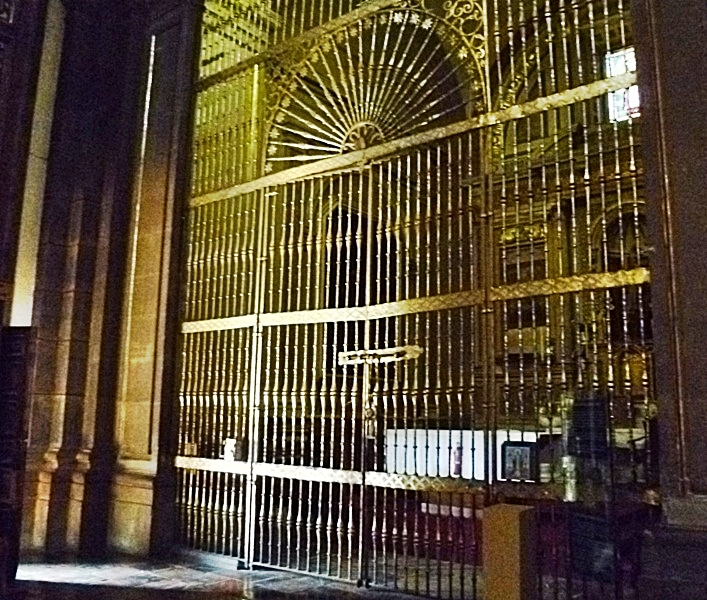 The glory of the stained glass still shone through ~ 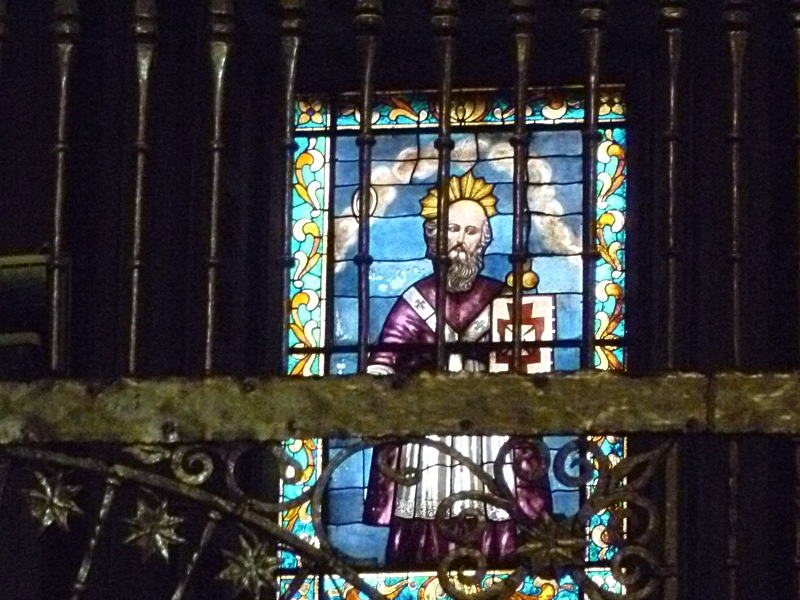 Crummy resolution, but I was trying to pick out the detail. These giant wooden screens are on the interior side of all three of the main outer doors. 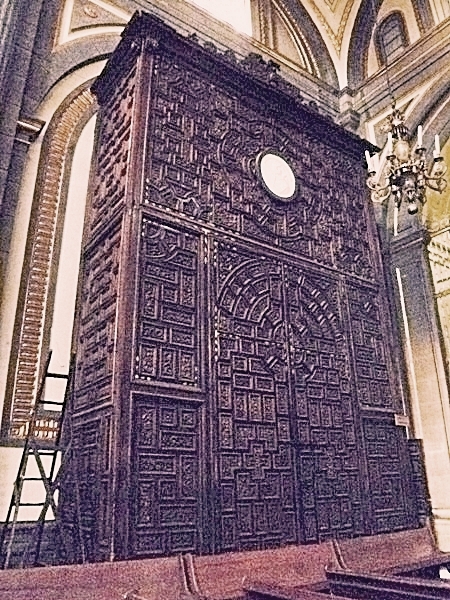 Here are some ladders between two of the wooden screens. The ladders and the person in the foreground give some idea of the height of the place. 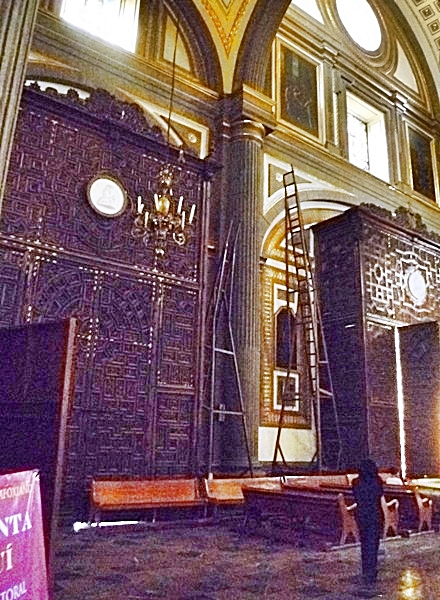 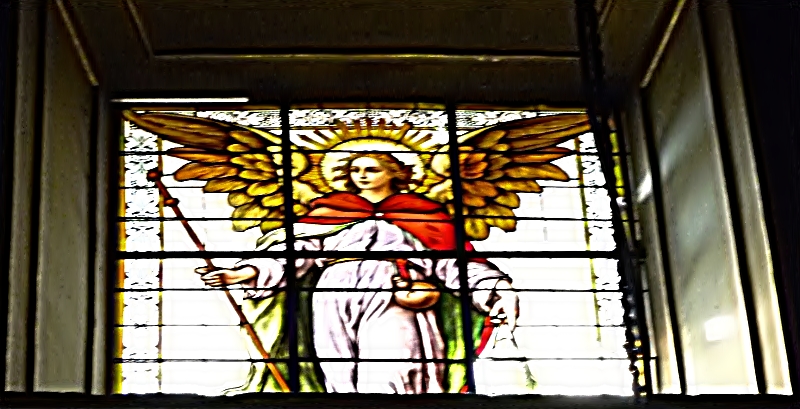 Now, out of the gloom ............ |
|
|
|
Post by bixaorellana on Apr 15, 2011 0:21:31 GMT
...... and into the glory!  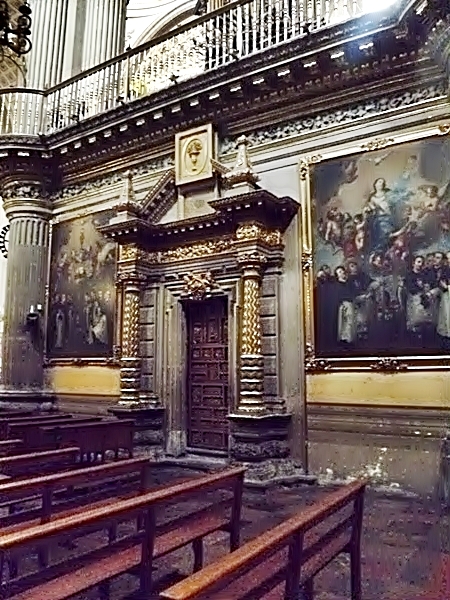 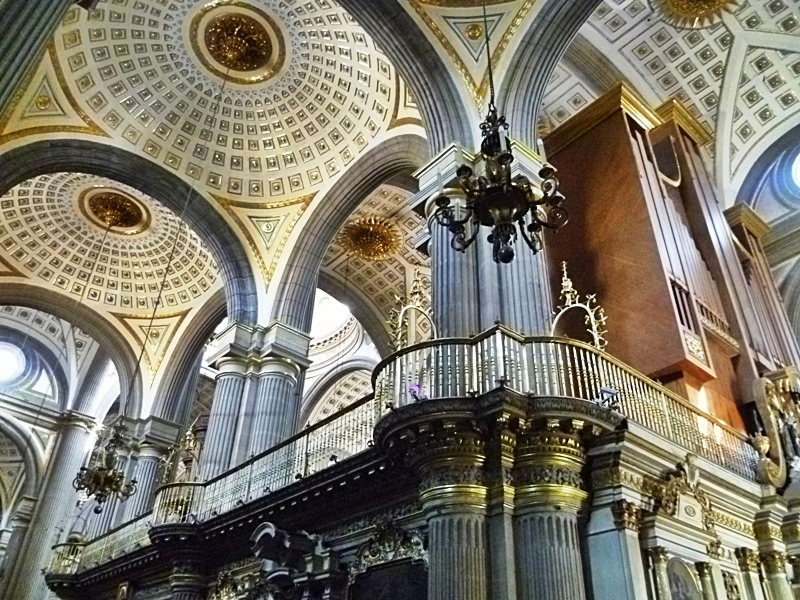 There are two organs in the choir loft, one of which was the gift of Charles V, the Holy Roman Emperor, who was also Charles I of Spain. 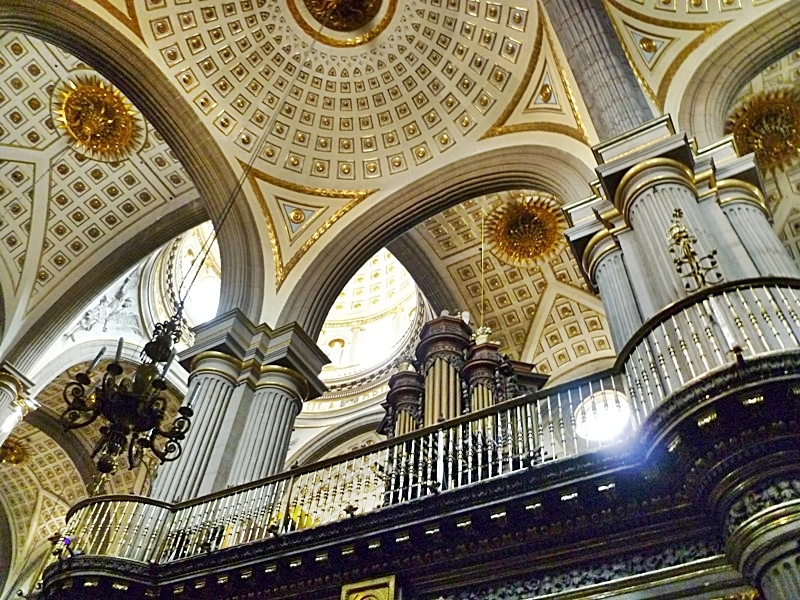 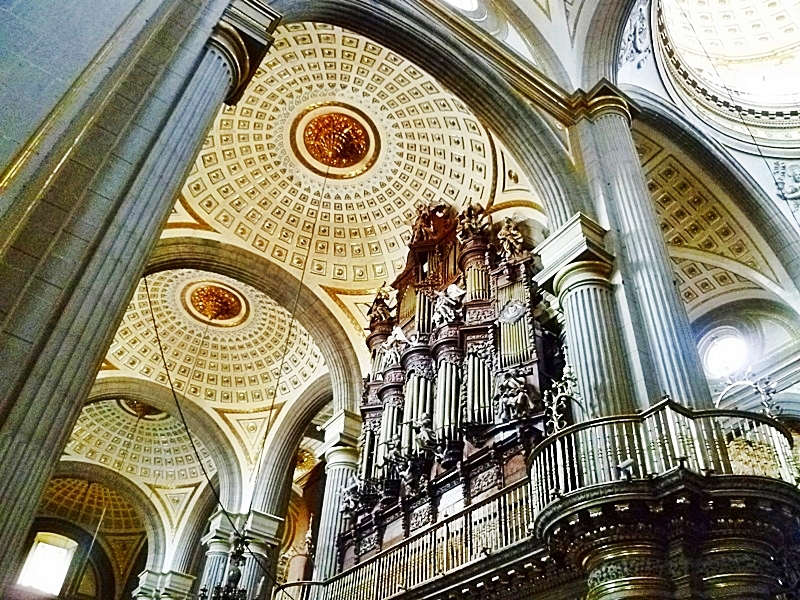 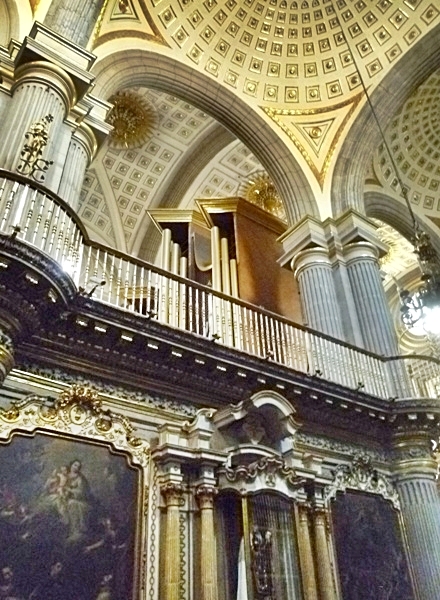 Please note that much of the yellow or blueish casts you're seeing on the columns and in the domes is not accurate, but a result of the low light & not terribly hiqh quality camera. 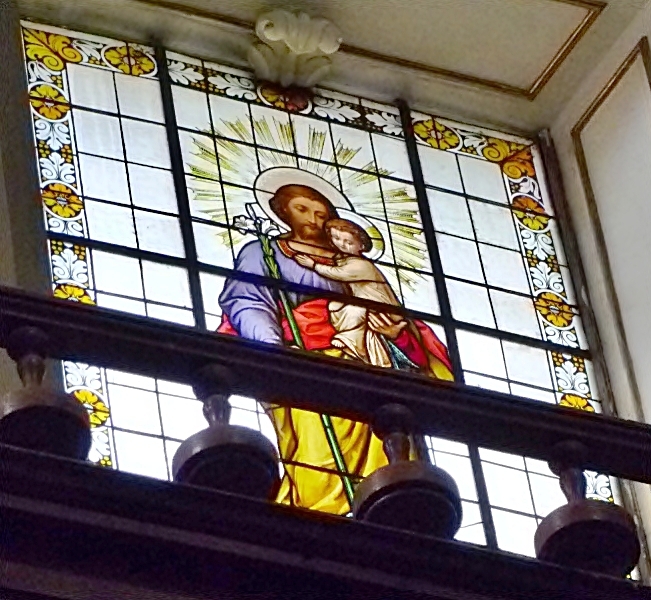 There is much, much more to show. I hope you all will stick around to see it all. |
|
|
|
Post by bixaorellana on Apr 15, 2011 4:43:39 GMT
 And here we encounter an anima sola, or lonely soul. I was not familiar with this type of depiction of souls suffering in Purgatory, but apparently the belief and the statues are common across Mexico. Looking at the image, I couldn't help but think how potent it must have appeared to the faithful of former centuries. If we today can be awed by the size and grandeur of this cathedral, how must it have appeared to rural indigenous people upon first beholding it?  We're moving past the choir loft into the middle of the church: 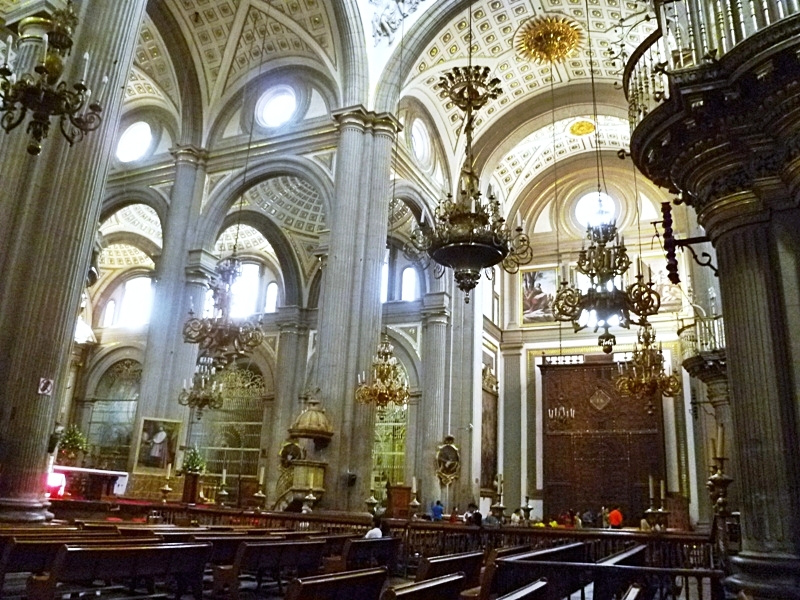 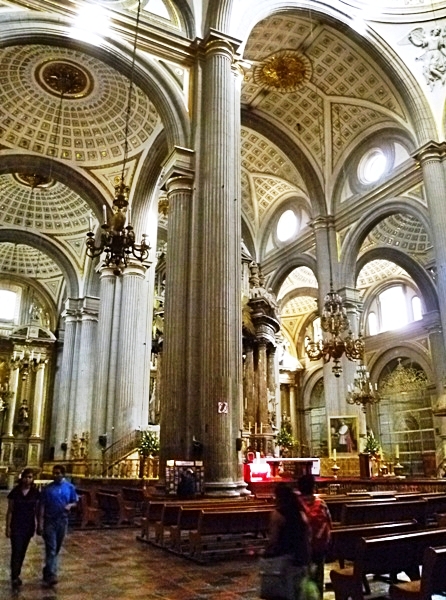 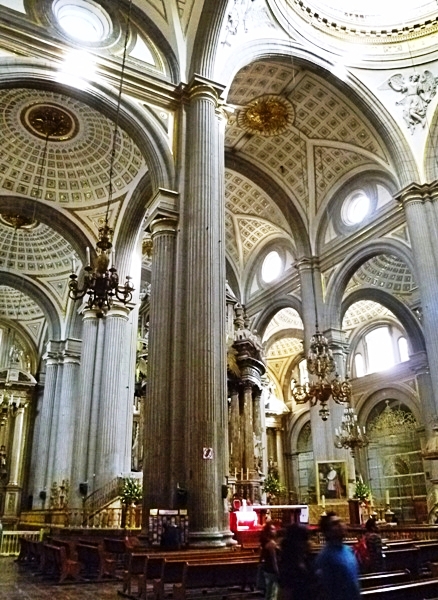 Facing the main altar ~ 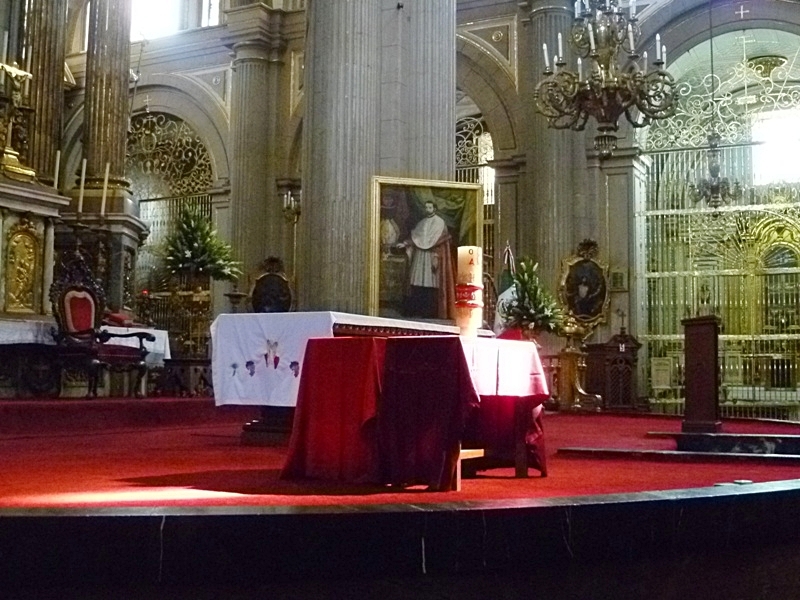 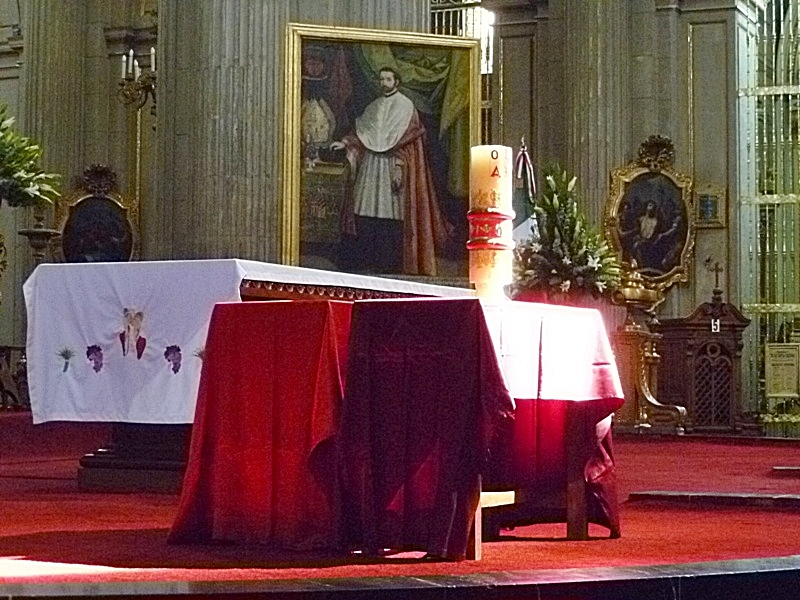 |
|
|
|
Post by bixaorellana on Apr 15, 2011 5:13:31 GMT
|
|
|
|
Post by bixaorellana on Apr 15, 2011 6:07:07 GMT
The statue of the Virgin in the center of the altar seemed to elude photographic capture, just as it eluded solid identification. I believe it is of wood and is by Manuel Tolsá, the designer of the altar, but cannot satisfactorily corroborate that.  Let's look at some details before moving on to the exquisite chapel beneath the painted dome of the cathedral. Onyx pulpit ~ 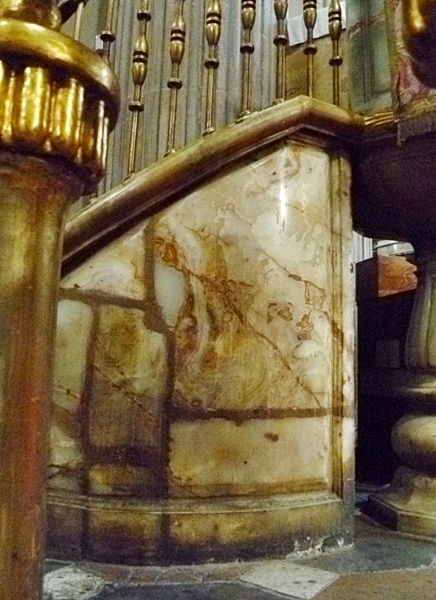 I believe this is part of the seat of the bishop, with a glimpse of the chapel beyond. 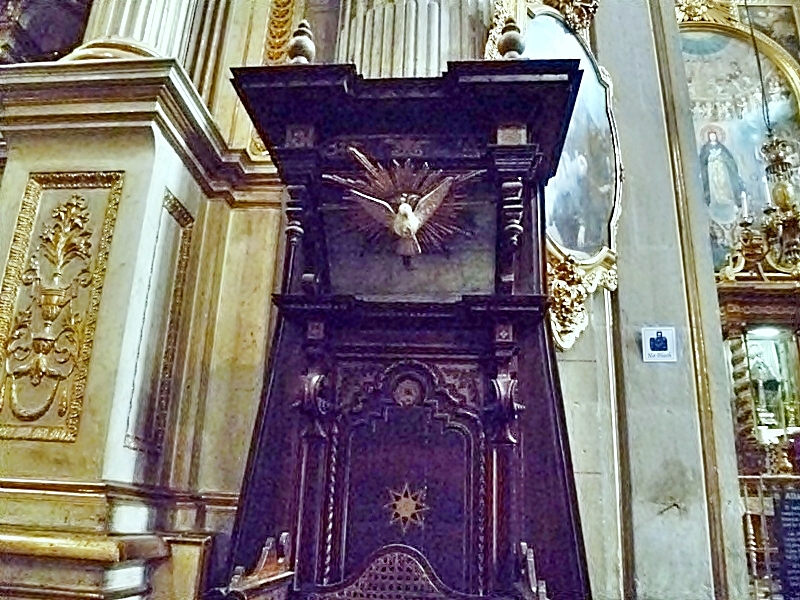 Angels in the architecture ~ 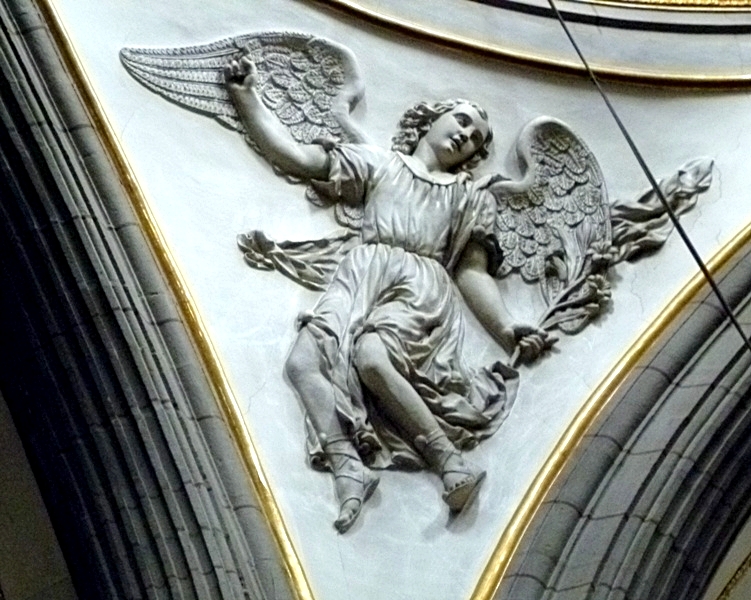 ... and glowing in the walls ~ 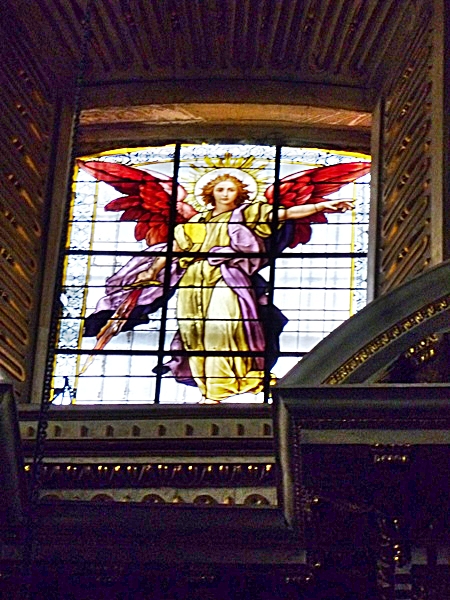 Help the seminarian. 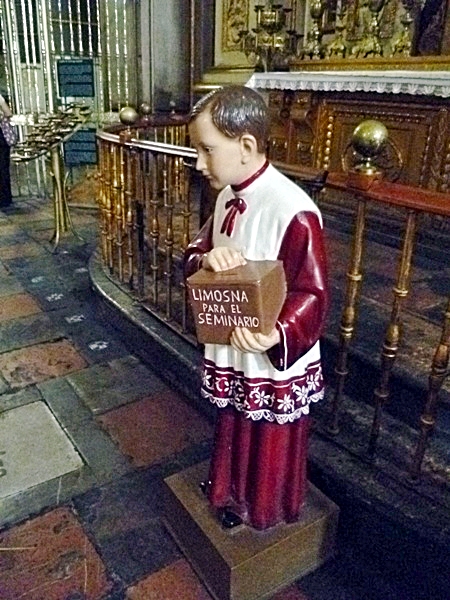 Onyx steps leading to another onyx pulpit ~ 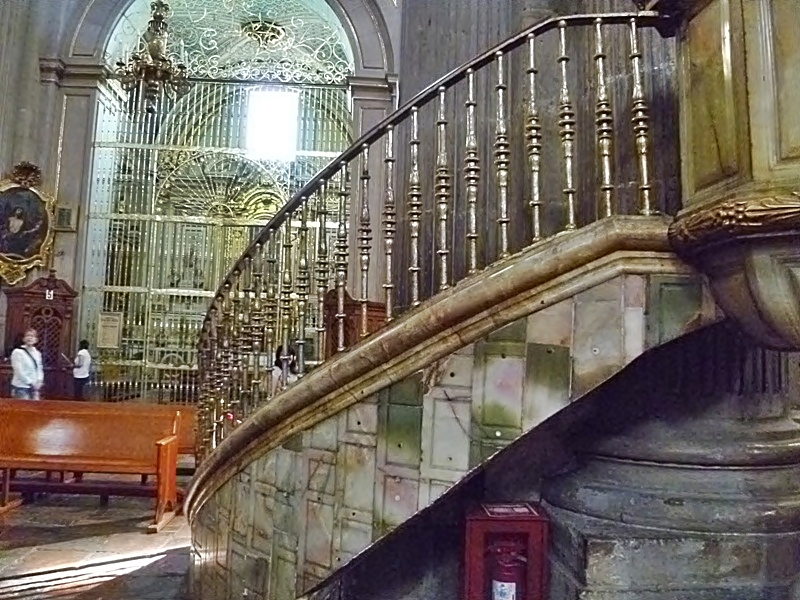  I do hope you all are enjoying this, and will come back to continue the tour. Yes, there is more to come. |
|
|
|
Post by tod2 on Apr 15, 2011 7:45:11 GMT
Wonderful church interior Bixa! I am taking time to not only scrutinise the gold, statues, ironwork, gorgeous ceiling, and so much more! I even noticed the altar cloth which has either shrunk around the embroidery or vice -versa  Most likely lovingly hand embroidered by one of the parishioners. I had an alter cloth made for my son's school chapel as a gift when he left but it was all machine done. Looking forward to the next instalment of this marvellous Catedral de Angelopolis. |
|
|
|
Post by tod2 on Apr 15, 2011 7:47:27 GMT
WoW and here it is! That is certainly some artwork on those ceilings Bixa - really and truly wonderful!
Hope there is more?
|
|
|
|
Post by bixaorellana on Apr 15, 2011 7:53:09 GMT
|
|
|
|
Post by bixaorellana on Apr 15, 2011 8:07:42 GMT
Oh, thank you so much, Tod! I was trying to fix a boo-boo when you were posting, so the ceiling in question wound up under instead of over your lovely comments. I went back & now see the homely detail of the shrunken embroidery. And yes, there is more to see, so let's move on ~~ We are all the way at the back of the church now. I'm thrilled to find these angels. They all look properly angelic, except for this one, who is rather twitty, despite his magnificent perch ~ 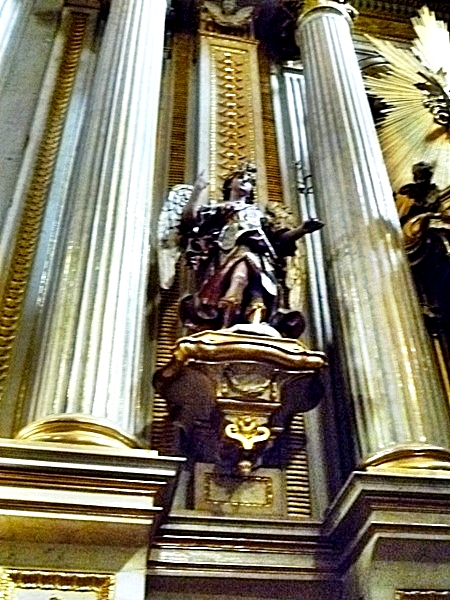 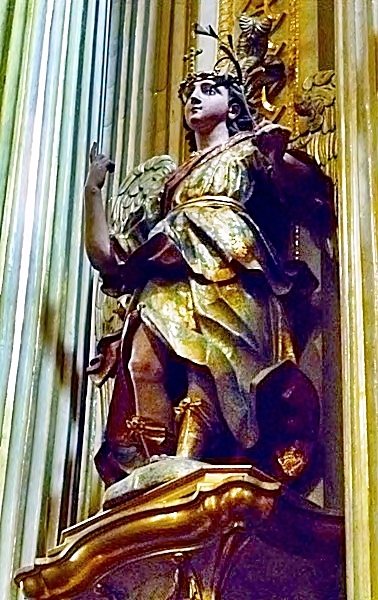 I have to say, if I were ever to steal something from a church, it would have to be this regal, yet endearing angel-boy ~   A magnificent warrior angel ~  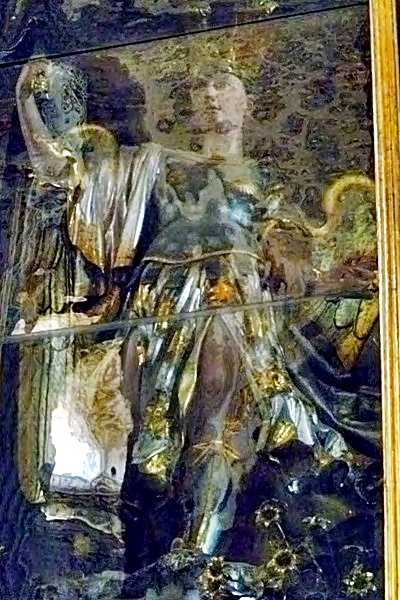 The figure atop his vitrine ~ 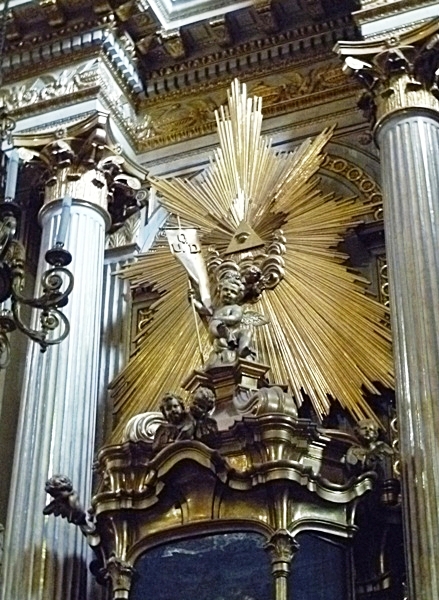  |
|
|
|
Post by bixaorellana on Apr 15, 2011 8:18:46 GMT
There is more to see, but I need to tell you something that started happening here at the very back of the cathedral. As I was looking at the angels, a howl echoed through the church. I thought that someone had brought in a very loud baby, so continued ambling around. But the noise returned, louder and more eerie, certainly no baby or child. It rose and swooped and broke and began again, mysterious and distressing. |
|
|
|
Post by tod2 on Apr 15, 2011 14:29:06 GMT
Still with you on this incredible stroll.....thinking about the strange utterance......thinking could it be someone confessing a dreadful dead and overtaken by remorse?.....perhaps not...maybe a priest casting out a demon?...perhaps not..
Oh the suspense!
|
|
|
|
Post by imec on Apr 15, 2011 14:38:18 GMT
Fantastic report bixa! This is truly stunning - and I was completely ignorant that something such as this existed there. Amazing! Thank you!
|
|
|
|
Post by Kimby on Apr 15, 2011 16:10:40 GMT
Beautiful pictorial and some fabulous raw material for the statues, wood, and wrought iron image bank threads, as well.
|
|
|
|
Post by bixaorellana on Apr 15, 2011 16:23:28 GMT
Heh heh heh, Tod ~~ aaaaall will be revealed in time.  Thank you for your attention and patience. Hey, thank you, Imec! Mexico probably didn't write the book on big, fancy churches, but it did what it could to catch up with, or even out-do, its European antecedents. I hope you'll look at the Puebla thread, which I think is a compelling argument for visiting Mexico. Also, in the churchly vein, there is a thread on Oaxaca's cathedral and on its showplace church, Santo Domingo. Speaking of which, Puebla also has a church called Sto. Domingo which appears to outshine the cathedral in ott magnfificence. Yet another reason for me to return to that beautiful city. |
|
|
|
Post by bixaorellana on Apr 15, 2011 16:27:40 GMT
Thank you, Kimby ~~ I didn't see your comment while I was posting.
I absolutely have to go out right now, but will be back later with the answer to the mystery and with more photos, including some very graphic ones, just in time for Holy Week.
|
|
|
|
Post by bjd on Apr 15, 2011 16:27:41 GMT
Another over-the-top Spanish-influenced church. It looks enormous. I would imagine it was built like that to impress the natives and show the power of the Church and the colonizer.
I agree that these churches are worth seeing, but I'm afraid I just don't like them. Too big, too flashy, overwhelming.
|
|
|
|
Post by bixaorellana on Apr 15, 2011 22:13:32 GMT
Bjd, I take your point and as I've commented elsewhere, there are certainly some churches in this country that affect me that way.
However, some of these buildings are so lovely, that being able to suspend judgment and just marvel can be quite transporting.
This particular cathedral has such excellent proportions, such a gentle color scheme, and such a soaring sense of space and light that it's pure aesthetic pleasure.
|
|
|
|
Post by bixaorellana on Apr 15, 2011 22:44:40 GMT
I've now made almost a complete circuit. Here's a detail I neglected to include earlier. They face the big altar and I suppose are for couples getting married. 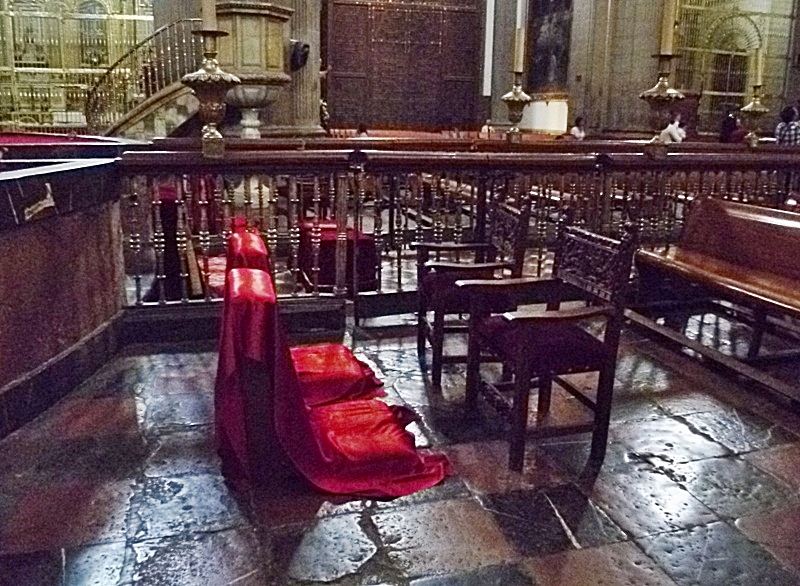 But what we've seen so far has mostly been a more mainstream manifestation of Christianity. Now we come to something that I associate with Mexican churches. This figure is called a Santo Entierro. In the past I've only ever seen these reclining figures of Jesus well shrouded in their glass cases, with only the faces showing, and the eyes closed. This one is uncovered, and unmistakably and graphically represents a dead, tortured man, if you would prefer not to look. |
|
|
|
Post by bixaorellana on Apr 15, 2011 23:24:15 GMT
And finally we are to learn the source of the tragic sounds. We have arrived at the altar dedicated to the Virgin of Pardon. This altar, in keeping with Spanish tradition, is found practically in the vestibule of the church, semi-isolated from the rest of the building. It avails itself of the wall that blocks the central nave from sight, in order that it may remain a place dedicated to special indulgences, for those who have begged a sacramental pardon or wish to do so. Source, in Spanish: gopuebla.com/guia-local/131/Catedral-de-PueblaThere, on her knees in front of the altar, facing flanked paintings of souls in Purgatory, was a woman sobbing her heart out. I did photograph her and video her, but the intensity of her grief made tears come to my eyes. Looking around, I could see other people were equally moved. 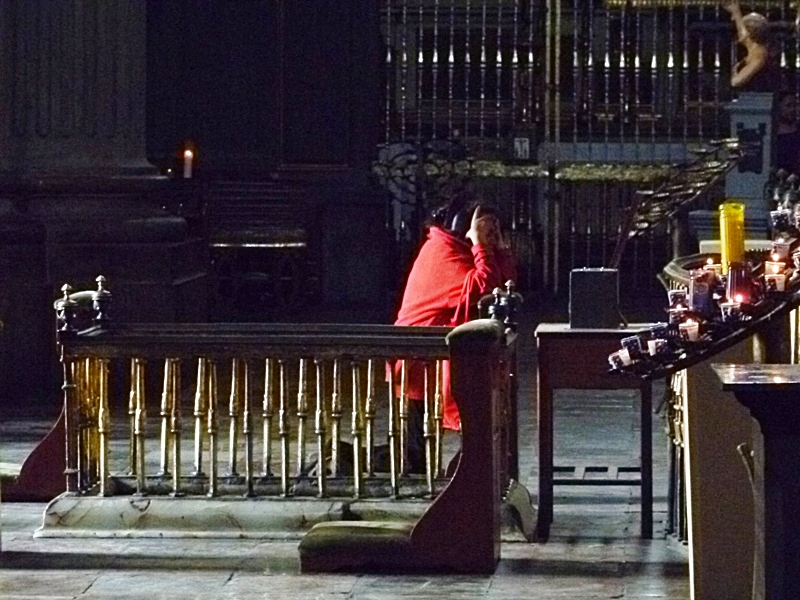 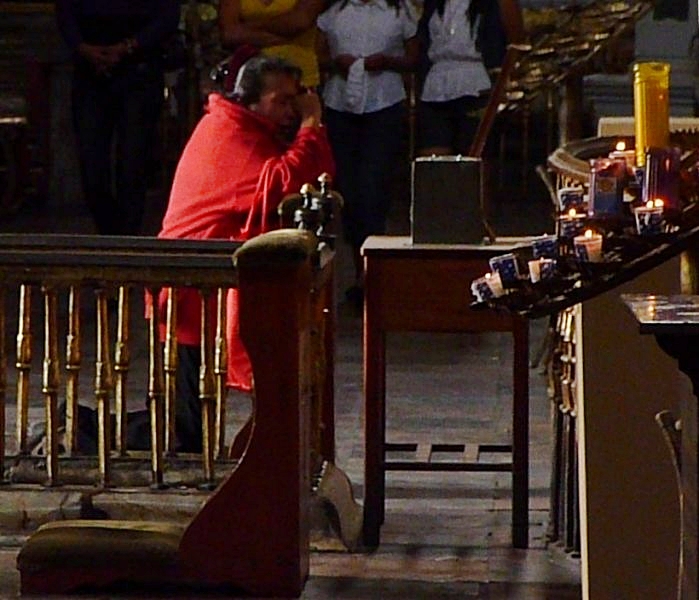 There are ladies in navy blue uniforms who apparently act as docents in the cathedral. One of them came up and attempted to console the woman, but to no avail. |
|
|
|
Post by bixaorellana on Apr 15, 2011 23:45:26 GMT
This is the painting on the right side, as you face the altar, with its attendant anima sola ~ 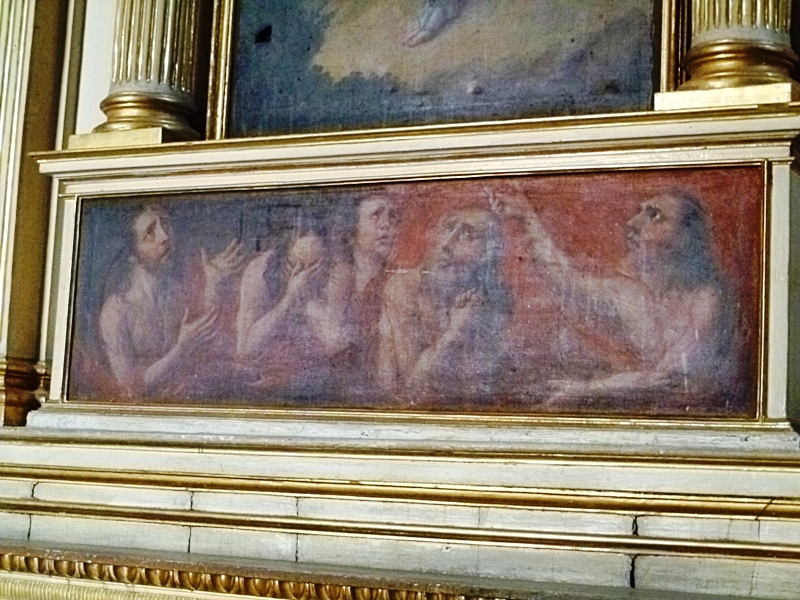 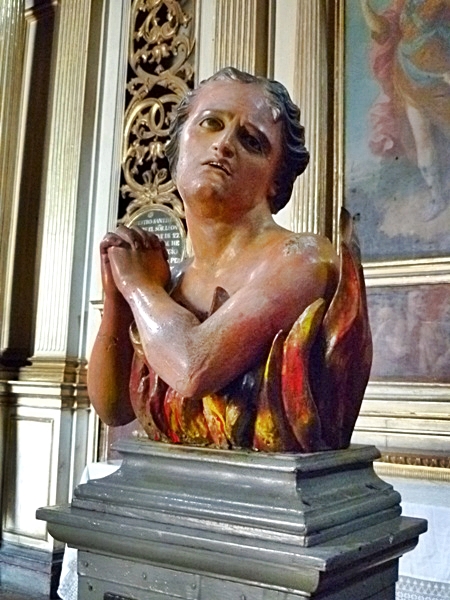 And here is the painting on the left, with an elderly anima sola ~ 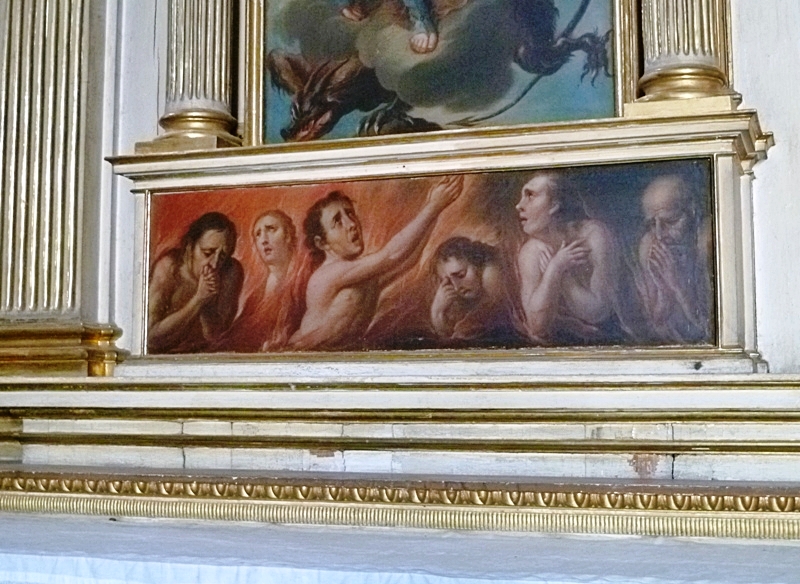 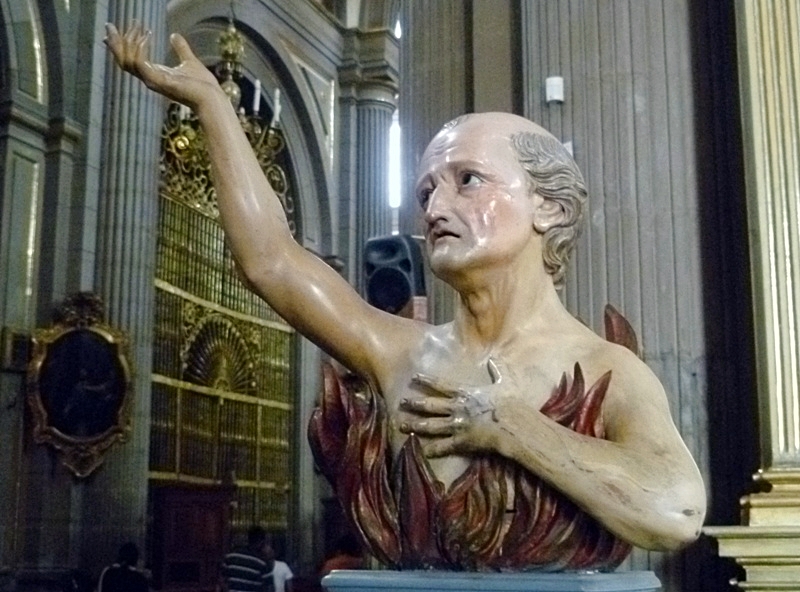 The old man has a slot for donations. It's touching to find such homely bits of piety amid such grand surroundings ~ 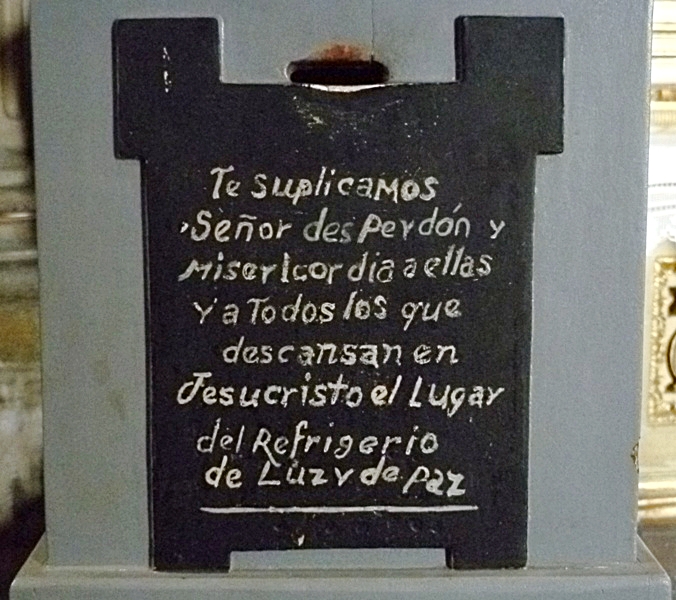 The sign reads: We ask of you, Lord of forgiveness and compassion, for them [souls in Purgatory] and for all those who rest in Jesus Christ, the place of refreshment of light and of peace. The statue of the Virgin of Pardon depicts the Immaculate Conception and is from the 18th century. 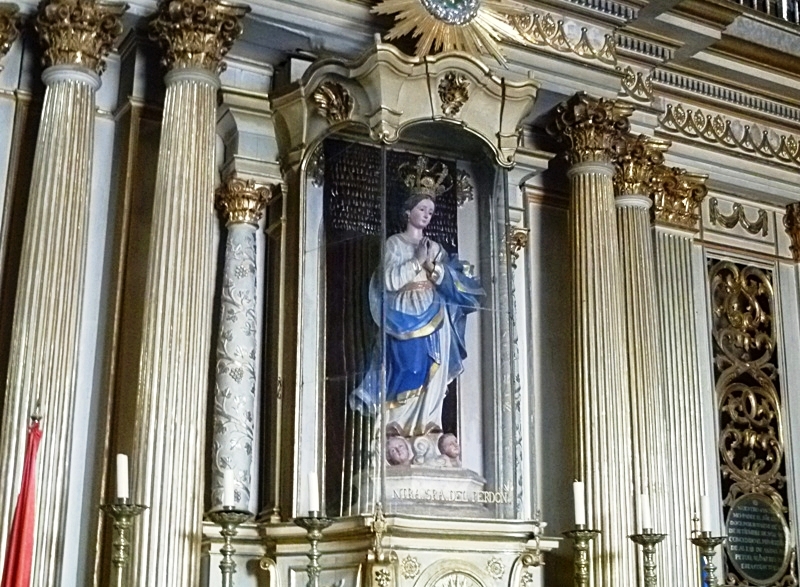 Note the many milagros pinned behind her head. These are probably only the more recent ones ~ 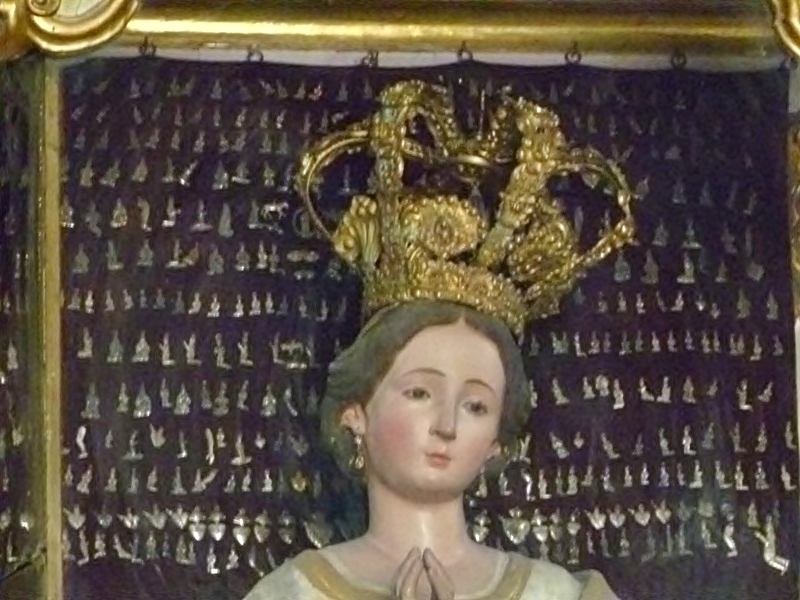 |
|
|
|
Post by bixaorellana on Apr 16, 2011 0:16:16 GMT
As I was taking those pictures, another of the navy-clad docents came up to the crying woman. She was older and motherly, and gently rubbed the distressed woman's back as she spoke softly to her. I heard her say, "Please come with me. I'll take you to a man who can help you. At that, the distraught woman finally got up and allowed herself to be led away. 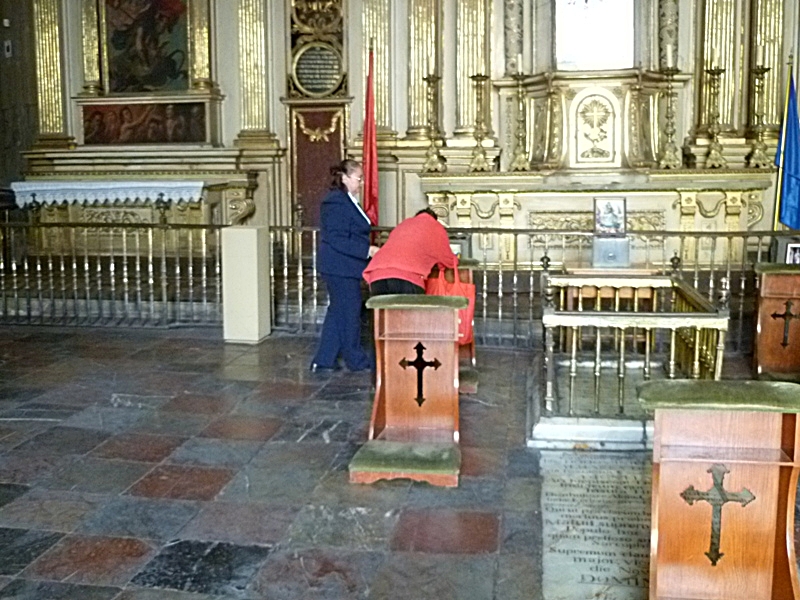 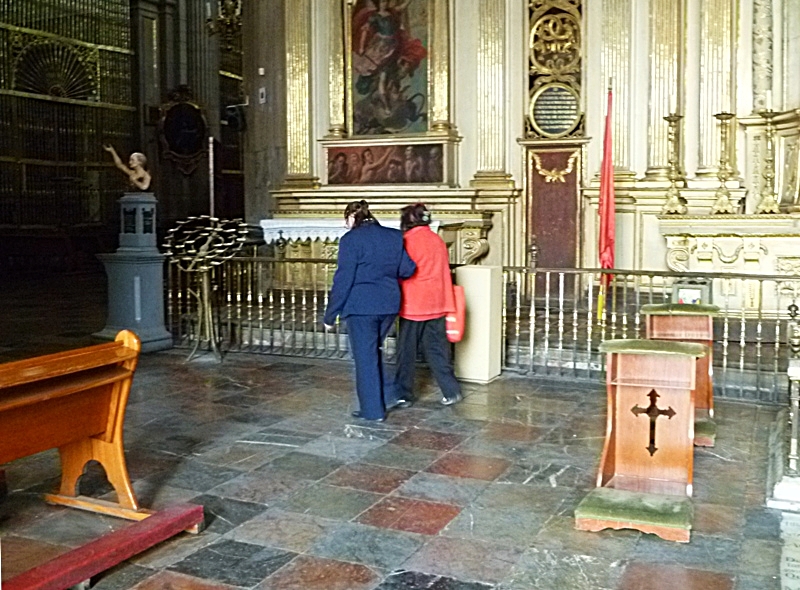 And so shall we lead ourselves outside, as our tour of the cathedral is over. Another view of one of the gates, showing the papal crown and the keys of St. Peter ~  Looking up from the side of the zócalo shown in the OP, admiring yet again the magnificent fence, the angels, and the amazing bell towers ~  Detail of fence showing the Mexican eagle on his nopal cactus, devouring a snake ~ 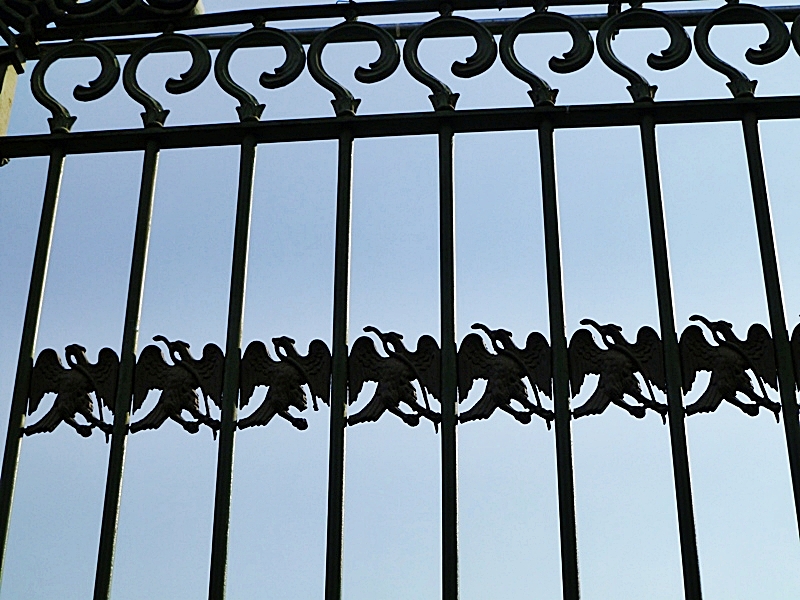 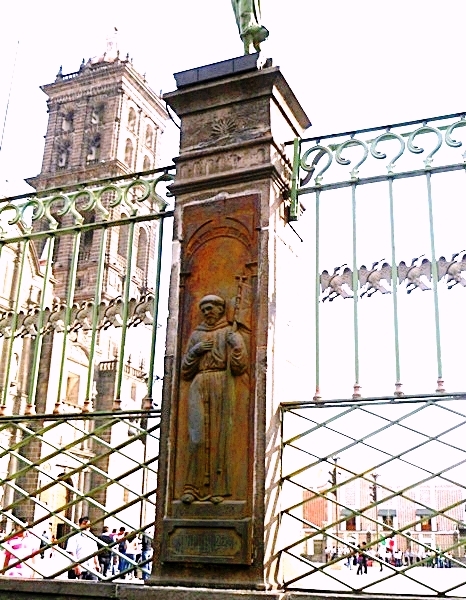 And so farewell to this building which anchors the main square, remaining as much a part of daily life in the modern world as it has in all the centuries past. |
|
|
|
Post by mich64 on Apr 16, 2011 18:10:02 GMT
This is an incredible photo essay Bixa. The church is truly unique to anyone else that I have seen. I was so moved by the woman sobbing, and thankful there is someone there to comfort those in distress.
Mich
|
|
|
|
Post by bixaorellana on Apr 17, 2011 0:08:01 GMT
Thank you, Mich. The incredible thing is that there was so much more to see. Really, it became sensory overload after a while. One of the reasons I tarried so long before visiting Puebla was because many of its museums and historical buildings had to be closed after the 1999 earthquake. One of those was the cathedral, which must have presented incredible challenges in renovation. I looked it up out of curiosity, & found this: After the 1999 earthquake, Puebla established a training center for the arts of restoration, the Escuela Taller de Capacitación en Restauración. It is led by Leopoldo García Lastra, an architect ...source: www.saudiaramcoworld.com/issue/201001/mexico.s.colors.of.three.cultures.htmThe old hospital (#20) I show in the Puebla thread has metal braces on all the columns, added after the '99 quake. We were told that there was a museum upstairs that was closed from a recent tremor, and could plainly see the cracks that had opened in the walls. I also didn't get to see the cooking museum, which really interests me, because it was closed for renovation. Yes, the docents are lovely and professional. I was fiddling with my camera & the flash went off. (this happens at least once every time I take pictures in a church  ) In Oaxaca, there's usually some old man lurking who comes up and snarls at or even berates the hapless photographer. When it happened in Puebla's cathedral, a docent told me quietly that flash wasn't allowed. I'm sure taking care of someone that lost in loud grief is not in their job descriptions, though, but that basic decency and common sense salved the situation. |
|
|
|
Post by Deleted on Apr 22, 2011 5:10:39 GMT
I am really perplexed by the insistence in the imagery of the "flames of purgatory." The people themselves are not actually on fire, nor are their clothes, and nobody is screaming in agony so this depiction seems inappropriate. (Never having read the bible and having no current plans to do so, I always thought the flames were supposed to be in hell and not purgatory anyway.) I guess it was just the easiest visual to show people "you don't want to go there." I don't really recall scenes of purgatory in European churches even though there are plenty of scenes of hell, so it's interesting that the Mexican church builders decided that it was an important stage in the religious process. I wonder if it corresponds to any local pre-Christian ideas of how to do things.
|
|
|
|
Post by bjd on Apr 22, 2011 6:52:18 GMT
I found the flames odd too, rather associating them with hell.
Remember in the La Lluvia Tambien movie, Kerouac, where the Spanish burn the Indians alive? Maybe some idea of flaming punishment has survived locally?
In any case, I find the religious depictions in Latin American art completely over the top compared to anything in Europe. The closest are indeed in Spain, but exaggerated even more in L America.
|
|
|
|
Post by bixaorellana on Apr 22, 2011 17:55:03 GMT
tsk, tsk. I don't think you all read the (loooooooong) link in #5.
When I was a child, the belief was that Purgatory was an interim place where you paid for your residual, unrepented badness before eventually moving on to heaven. Thus, you suffered, but not as fiercely as in hell, nor forever. Live people could help shorten the stint of souls in purgatory through prayer and could even save up time to be cut off their own sentences when they died and wound up there. Now, how much of this was official church doctrine, and how much of it was simply entrenched belief, I don't know. I've been told that the Roman Catholic church no longer considers Purgatory to be an actual place of physical suffering.
At any rate, the concept of Purgatory existed in Europe before the invasion of the New World and was imported along with everything else. But then Europe had the whole Reformation plus later waves of philosophy and rational thought that would have tempered much of the weirder beliefs and depictions on that continent over time.
As I said, I didn't know these anima sola statues until I went to Puebla. However, in Michoacán it seems that every church has a huge set of three crucified men -- Christ & the two thieves crucified alongside him. In all of those sets, Christ is nailed but the two thieves have their arms slung over the crosspieces. The anatomically correct dislocated shoulders are shown with what I can only call glee.
I once asked a Mexican friend how it was -- aside from forced baptisms, etc. -- that Mexico embraced the more horrible aspects of the conquerors' religion. His answer was that the indigenous religions were "muy pesada", or grim, heavy-duty.
Bjd, this kind of scary or gory statuary and paintings are all over Latin America?
|
|
|
|
Post by bjd on Apr 22, 2011 18:02:39 GMT
Bixa, in the main museum in Quito, Ecuador the ground floor has all kinds of interesting indigenous art, old stuff like statues, pottery, etc. Upstairs, to the "new" stuff, i.e. the colonial period and it's all gory religious art. Very few native sort of things but lots of crucified Christs with blood all over, gaping wounds, etc.
As far as the depiction of Christ and the two thieves, I believe only Christ was nailed to the cross, in order to punish him more. The others were indeed always shown just tied on. Most churches in my experience only show Christ, except maybe on paintings.
|
|


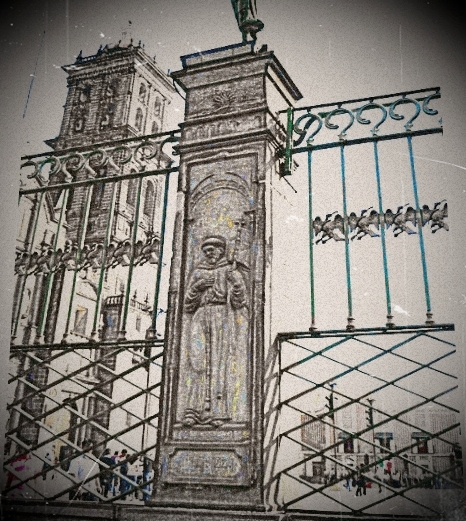






























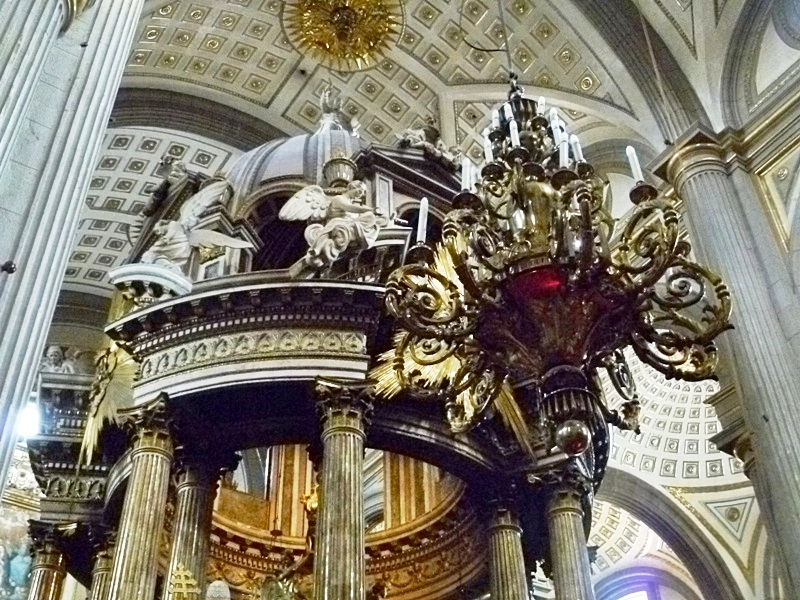
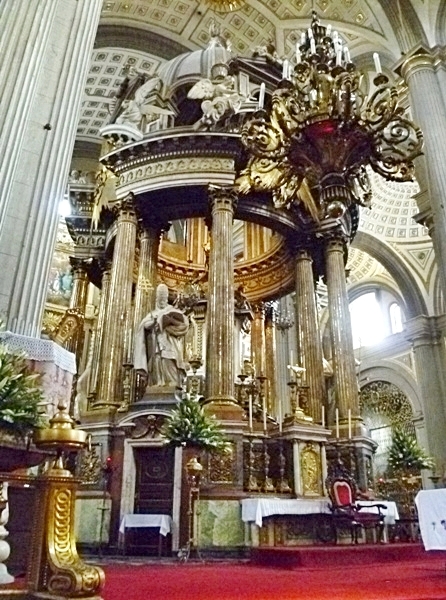

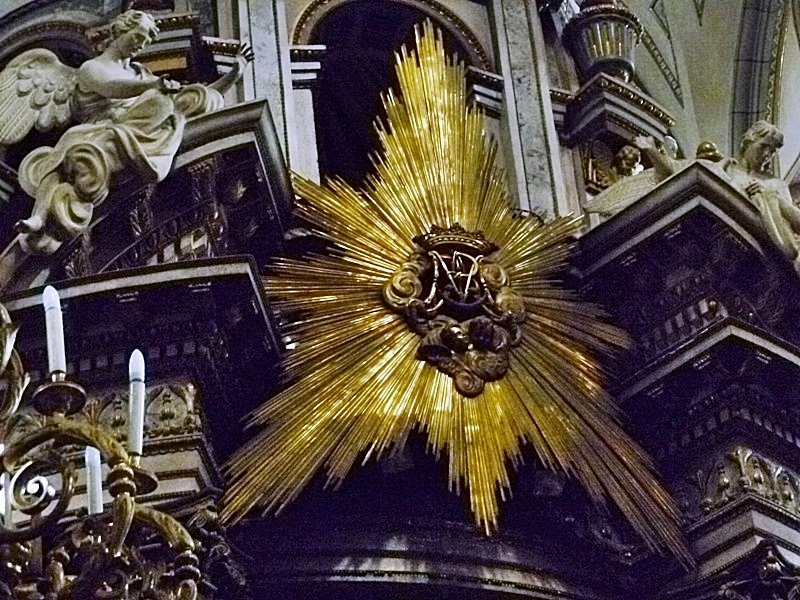

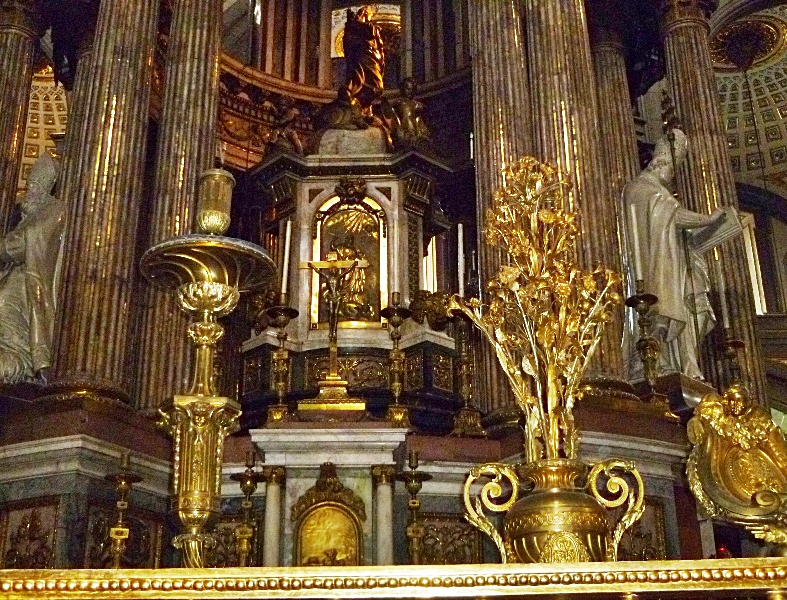
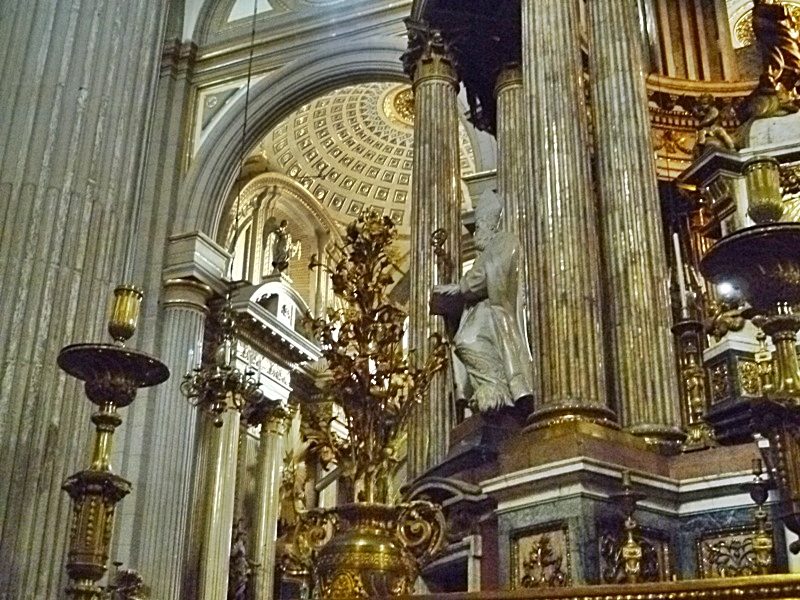
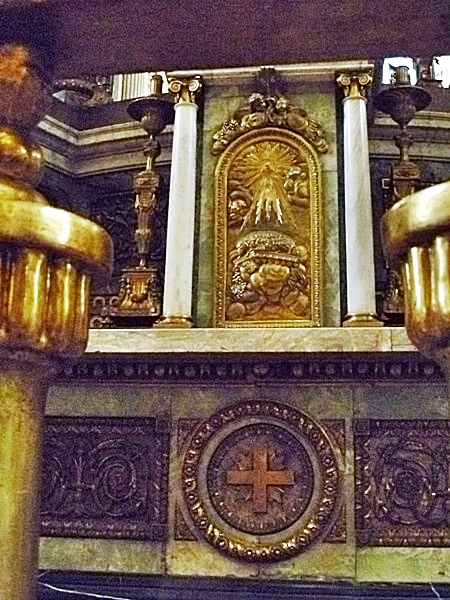
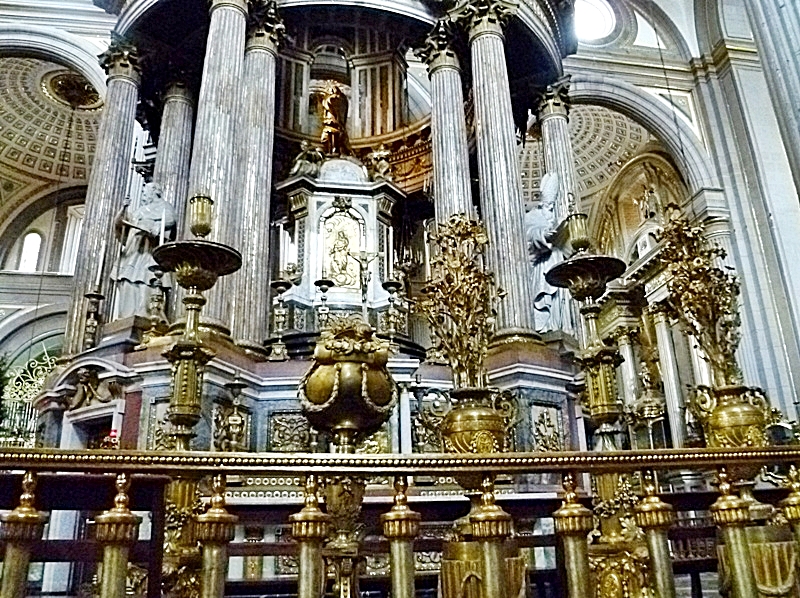









 Most likely lovingly hand embroidered by one of the parishioners.
Most likely lovingly hand embroidered by one of the parishioners.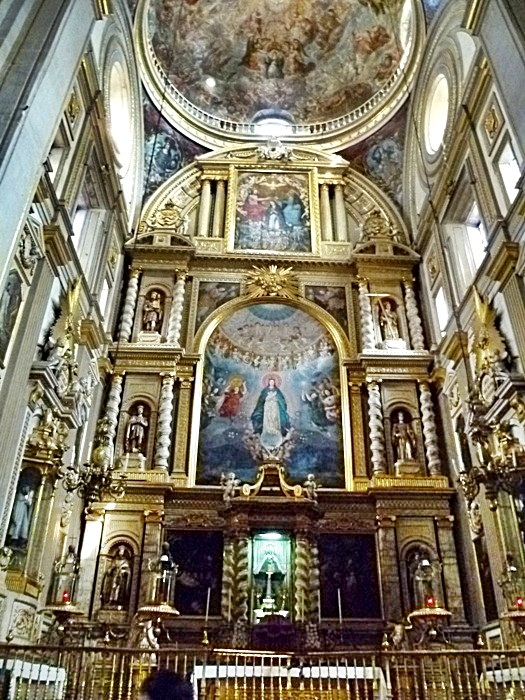

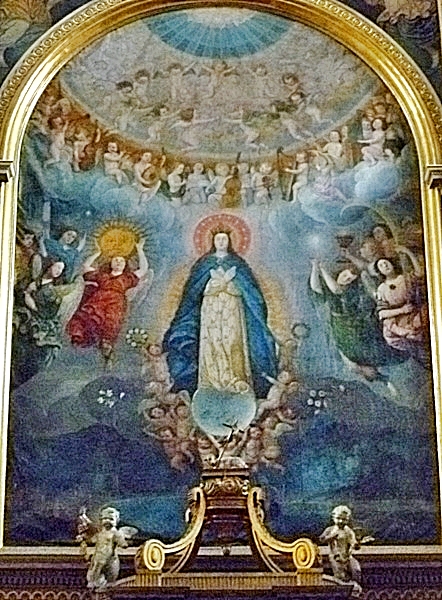
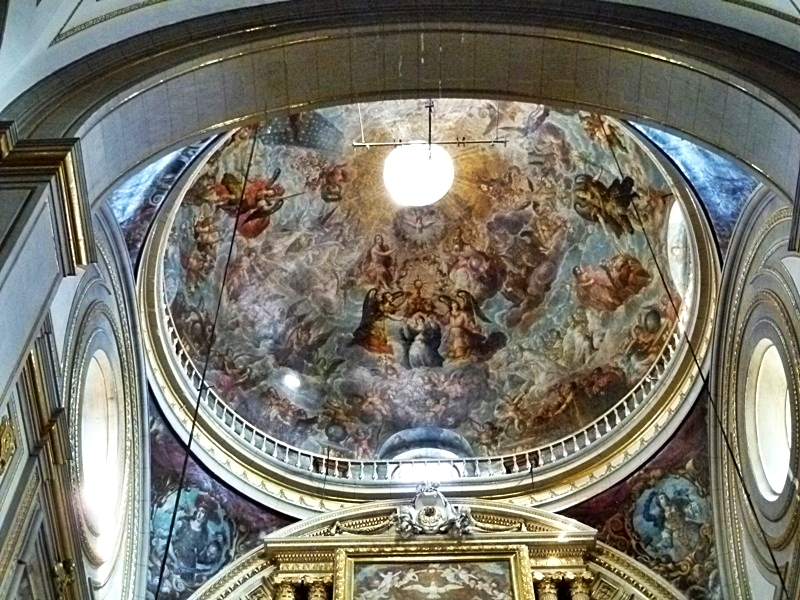









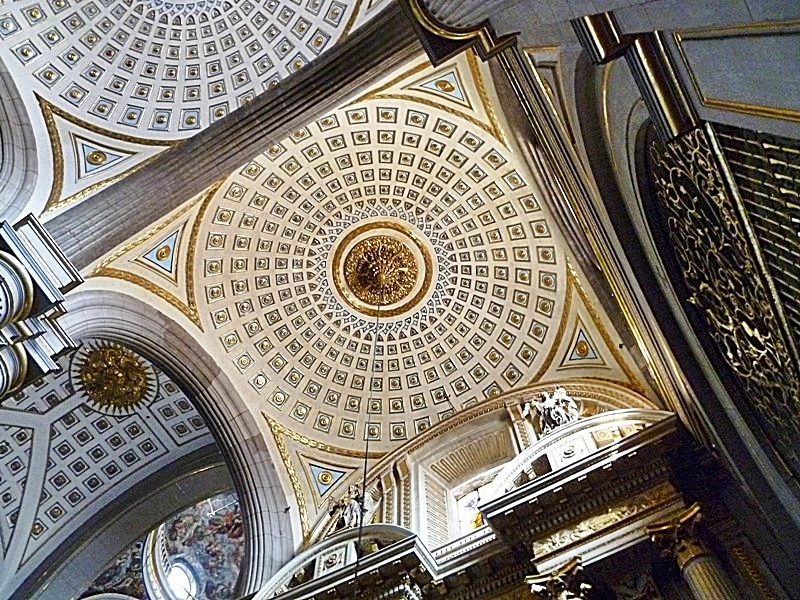
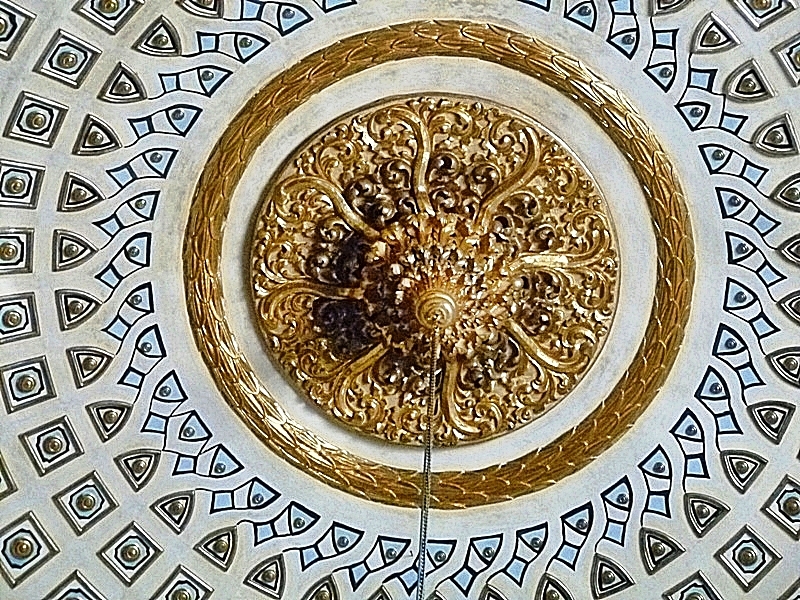
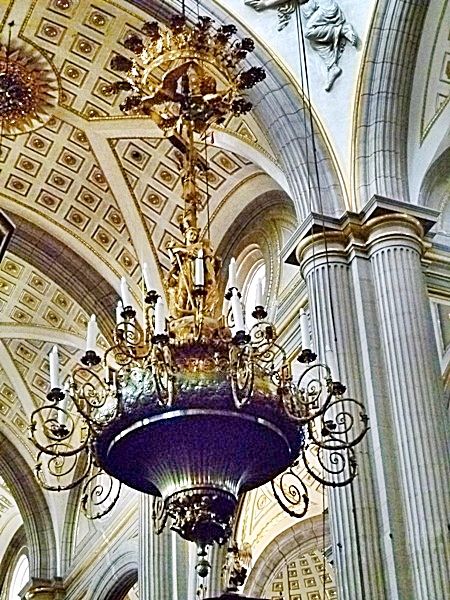
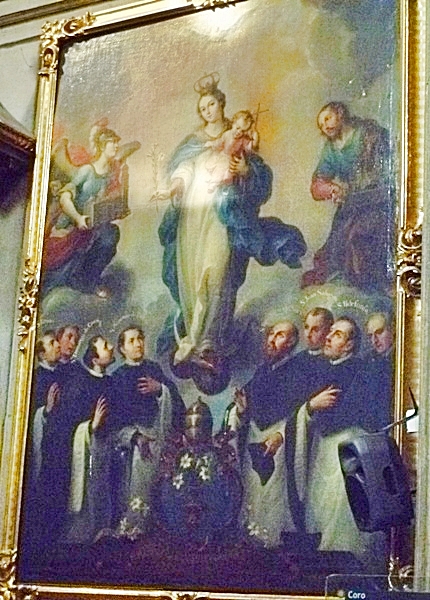
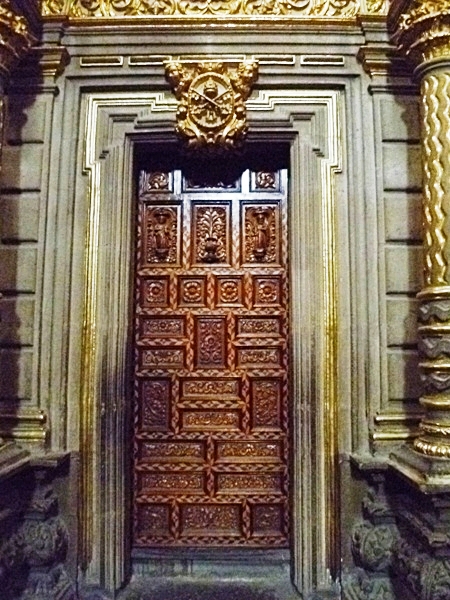
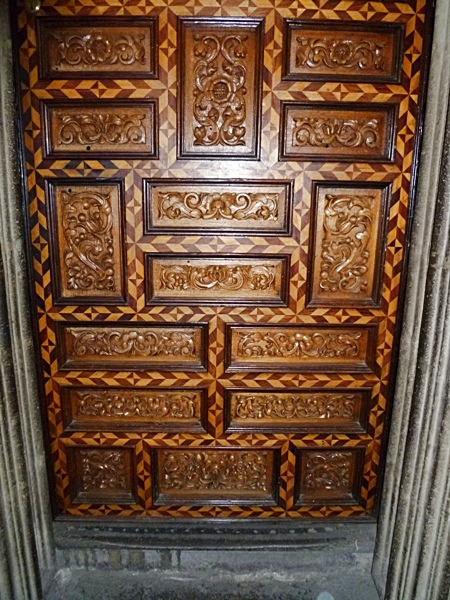
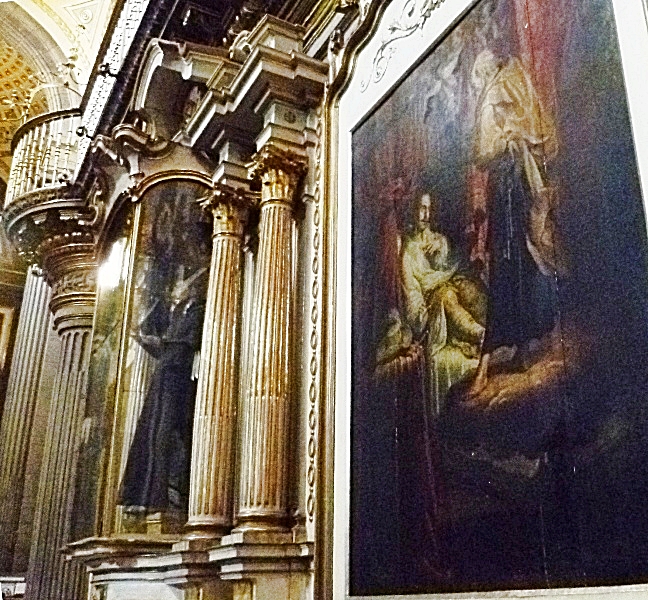

 Thank you for your attention and patience.
Thank you for your attention and patience.
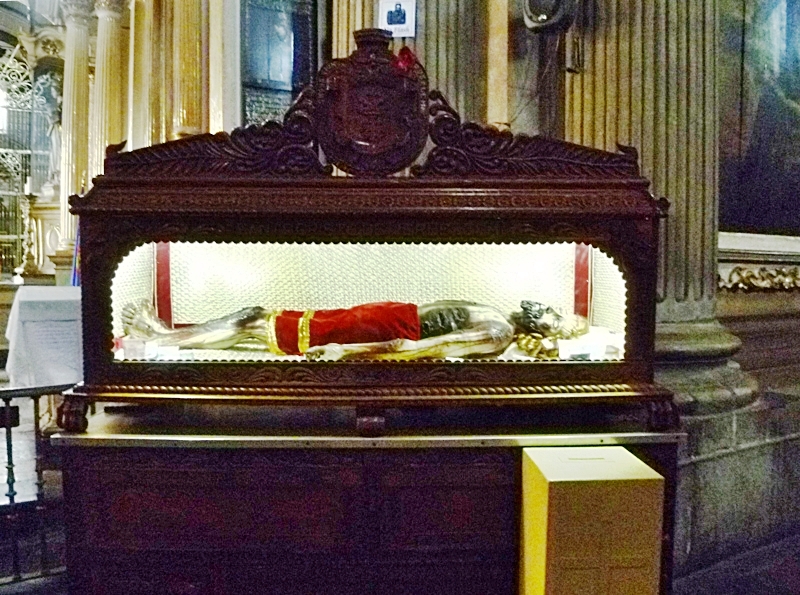
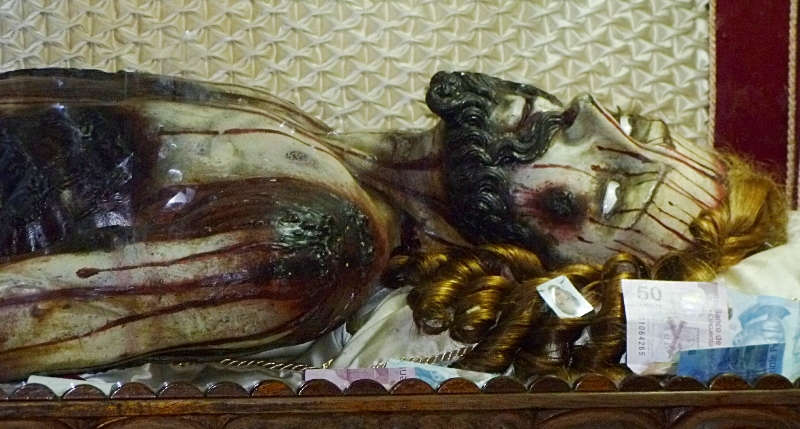
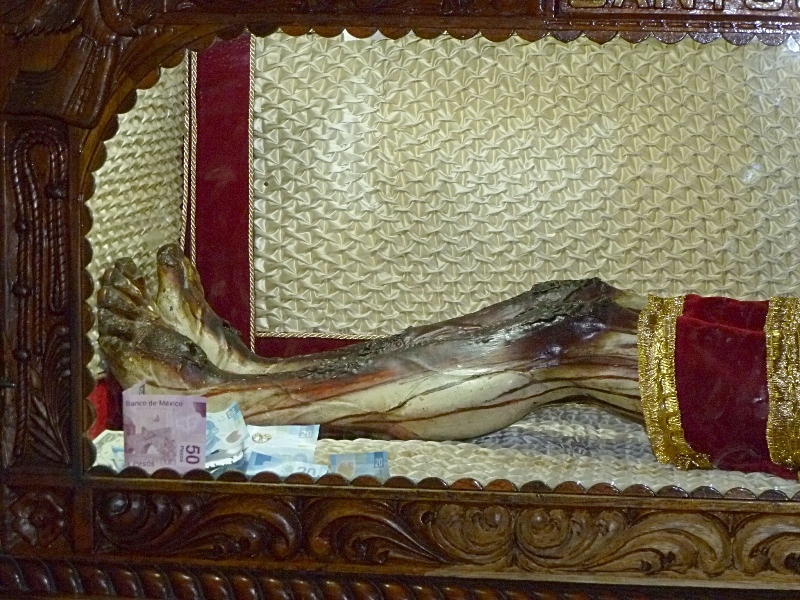
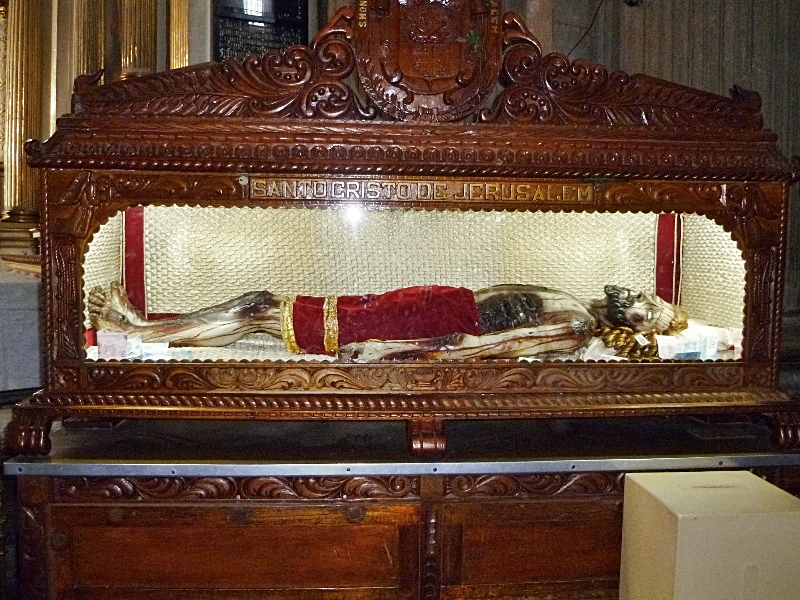















 ) In Oaxaca, there's usually some old man lurking who comes up and snarls at or even berates the hapless photographer. When it happened in Puebla's cathedral, a docent told me quietly that flash wasn't allowed. I'm sure taking care of someone that lost in loud grief is not in their job descriptions, though, but that basic decency and common sense salved the situation.
) In Oaxaca, there's usually some old man lurking who comes up and snarls at or even berates the hapless photographer. When it happened in Puebla's cathedral, a docent told me quietly that flash wasn't allowed. I'm sure taking care of someone that lost in loud grief is not in their job descriptions, though, but that basic decency and common sense salved the situation.